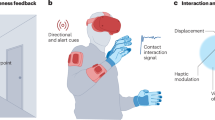Abstract
This paper focuses on the study of mid-air gestural interaction and haptic means of immersion in virtual environments to design a wearable kinesthetic feedback system based on vibro-tactile feedback mechanisms. The paper gives special attention to the design and prototyping of the wearable system and the use of low-cost optical hand tracking devices. The complete implementation of the system is comprised of a motion tracking sensor, used to identify and monitor the user’s hand position and gestures, and a wearable device based on low-cost microcontroller technologies and vibration motors for producing the haptic rendering. The wearable device is mounted on the user’s hand (fingers, palm and wrist), with the aim of producing feedback in real time when interacting with virtual objects in virtual environments. In this paper we present the design of the wearable kinesthetic feedback system, the implementation of the haptic rendering mechanisms and a preliminary evaluation of its usability from a user experience perspective.
Access this chapter
Tax calculation will be finalised at checkout
Purchases are for personal use only
Similar content being viewed by others
References
Attwenger, A.: Advantages and Drawbacks of Gesture-Based Interaction. Grin Verlag (2017)
Bruder, G., Steinicke, F., Sturzlinger, W.: To touch or not to touch? Comparing 2D touch and 3D mid-air interaction on stereoscopic tabletop surfaces. In: Proceedings of the 1st Symposium on Spatial User Interaction. pp. 9–16. ACM, New York (2013). https://doi.org/10.1145/2491367.2491369
Spano, L.D.: Developing touchless interfaces with GestIT. In: Paternò, F., de Ruyter, B., Markopoulos, P., Santoro, C., van Loenen, E., Luyten, K. (eds.) AmI 2012. LNCS, vol. 7683, pp. 433–438. Springer, Heidelberg (2012). https://doi.org/10.1007/978-3-642-34898-3_39
Nguyen, V.T.: Enhancing touchless interaction with the leap motion using a haptic glove. Comput. Sci. (2014)
O’hara, K., Harper, R., Mentis, H., Sellen, A., Taylor, A.: On the naturalness of touchless: putting the “interaction” back into NUI. ACM Trans. Comput. Hum. Interact. (TOCHI) 20, 25 (2013)
Ernst, M.O., Banks, M.S.: Humans integrate visual and haptic information in a statistically optimal fashion. Nature 415, 429 (2002)
Ernst, M.O., Banks, M.S., Bülthoff, H.H.: Touch can change visual slant perception. Nat. Neurosci. 3, 69 (2000)
Ernst, M.O., Bülthoff, H.H.: Merging the senses into a robust percept. Trends Cogn. Sci. 8, 162–169 (2004)
Gepshtein, S., Burge, J., Ernst, M.O., Banks, M.S.: The combination of vision and touch depends on spatial proximity. J. Vis. 5, 7 (2005)
Lin, M.C., Otaduy, M.: Haptic Rendering: Foundations, Algorithms, and Applications. CRC Press, Boca Raton (2008)
Maereg, A.T., Nagar, A., Reid, D., Secco, E.L.: Wearable vibrotactile haptic device for stiffness discrimination during virtual interactions. Front. Robot. AI 4, 42 (2017). https://doi.org/10.3389/frobt.2017.00042
Fogtmann, M.H., Fritsch, J., Kortbek, K.J.: Kinesthetic interaction: revealing the bodily potential in interaction design. In: Proceedings of the 20th Australasian Conference on Computer-Human Interaction: Designing for Habitus and Habitat, pp. 89–96. ACM, New York (2008). https://doi.org/10.1145/1517744.1517770
de la Barré, R., Chojecki, P., Leiner, U., Mühlbach, L., Ruschin, D.: Touchless interaction-novel chances and challenges. In: Jacko, J.A. (ed.) HCI 2009. LNCS, vol. 5611, pp. 161–169. Springer, Heidelberg (2009). https://doi.org/10.1007/978-3-642-02577-8_18
Vogiatzidakis, P., Koutsabasis, P.: Gesture elicitation studies for mid-air interaction: a review. MTI 2, 65 (2018). https://doi.org/10.3390/mti2040065
Zhang, Z.: Microsoft kinect sensor and its effect. IEEE Multimed. 19, 4–10 (2012). https://doi.org/10.1109/MMUL.2012.24
Carter, J., Fourney, D.: Research based tactile and haptic interaction guidelines. In: GOTHI 2005, p. 9 (2005)
Bicchi, A., Buss, M., Ernst, M.O., Peer, A. (eds.): The Sense of Touch and Its Rendering: Progress in Haptics Research. Springer Tracts in Advanced Robotics, vol. 45. Springer, Heidelberg (2008). https://doi.org/10.1007/978-3-540-79035-8
Salisbury, K., Conti, F., Barbagli, F.: Haptic rendering: introductory concepts. IEEE Comput. Graph. Appl. 24, 24–32 (2004). https://doi.org/10.1109/MCG.2004.1274058
Freeman, E., Brewster, S., Lantz, V.: Tactile feedback for above-device gesture interfaces: adding touch to touchless interactions. In: Proceedings of the 16th International Conference on Multimodal Interaction, pp. 419–426. ACM, New York (2014). https://doi.org/10.1145/2663204.2663280
Mazzoni, A., Bryan-Kinns, N.: Mood Glove: a haptic wearable prototype system to enhance mood music in film. Entertain. Comput. 17, 9–17 (2016). https://doi.org/10.1016/j.entcom.2016.06.002
Feng, Y.-L., Fernando, C.L., Rod, J., Minamizawa, K.: Submerged haptics: a 3-DOF fingertip haptic display using miniature 3D printed airbags. In: ACM SIGGRAPH 2017 Emerging Technologies. pp. 22:1–22:2. ACM, New York (2017). https://doi.org/10.1145/3084822.3084835
PowerClaw. https://vivoxie.com/en/powerclaw/index. Accessed 4 May 2020
Kim, M., Jeon, C., Kim, J.: A study on immersion and presence of a portable hand haptic system for immersive virtual reality. Sensors 17, 1141 (2017). https://doi.org/10.3390/s17051141
Carter, T., Seah, S.A., Long, B., Drinkwater, B., Subramanian, S.: UltraHaptics: multi-point mid-air haptic feedback for touch surfaces. In: Proceedings of the 26th Annual ACM Symposium on User Interface Software and Technology, pp. 505–514. ACM, New York (2013). https://doi.org/10.1145/2501988.2502018
Goodwin, K.: Designing for the Digital Age: How to Create Human-Centered Products and Services. Wiley, Hoboken (2009)
Benyon, D.: Designing Interactive Systems: A Comprehensive Guide to HCI and Interaction Design. Pearson, Boston (2013)
Partheniadis, K., Stavrakis, M.: Design and evaluation of a digital wearable ring and a smartphone application to help monitor and manage the effects of Raynaud’s phenomenon. Multimed. Tools Appl. 78(3), 3365–3394 (2018). https://doi.org/10.1007/s11042-018-6514-3
Kordatos, G., Stavrakis, M.: Design and evaluation of a wearable system to increase adherence to rehabilitation programmes in acute cruciate ligament (CL) rupture. Multimed. Tools Appl. (2019). https://doi.org/10.1007/s11042-019-08502-3
Vosinakis, S., Koutsabasis, P., Makris, D., Sagia, E.: A kinesthetic approach to digital heritage using leap motion: the cycladic sculpture application. In: 2016 8th International Conference on Games and Virtual Worlds for Serious Applications (VS-GAMES), pp. 1–8. IEEE (2016). https://doi.org/10.1109/VS-GAMES.2016.7590334
Author information
Authors and Affiliations
Corresponding author
Editor information
Editors and Affiliations
Rights and permissions
Copyright information
© 2020 Springer Nature Switzerland AG
About this paper
Cite this paper
Sagia, E.E.M., Stavrakis, M. (2020). Design and Prototyping of a Wearable Kinesthetic Haptic Feedback System to Support Mid-Air Interactions in Virtual Environments. In: Florez, H., Misra, S. (eds) Applied Informatics. ICAI 2020. Communications in Computer and Information Science, vol 1277. Springer, Cham. https://doi.org/10.1007/978-3-030-61702-8_26
Download citation
DOI: https://doi.org/10.1007/978-3-030-61702-8_26
Published:
Publisher Name: Springer, Cham
Print ISBN: 978-3-030-61701-1
Online ISBN: 978-3-030-61702-8
eBook Packages: Computer ScienceComputer Science (R0)




